Dating apps have become more than just tools for swiping, they are platforms where people can interact with like minded individuals and create a bond with them. Over the years, these platforms have evolved from simple match-and-chat systems into dynamic, feature-rich experiences designed to make finding a connection feel more authentic and meaningful.
But let’s be honest: users today expect more than just swipes and matches. They want dating apps that feel personal, secure, and truly tailored to their needs. This demand has sparked exciting dating app development trends, from AI-driven matchmaking that understands your preferences to enhanced privacy features that make the experience feel safe and stress-free.
As the dating landscape continues to evolve, these trends are shaping how people connect in the digital age. Let’s dive into the most compelling innovations transforming dating apps today.
Top Innovative Trends in Dating App Development
From improved security measures to more personalized matchmaking, the evolution of dating apps is driven by the combination of technical advancements and the demands of the users.
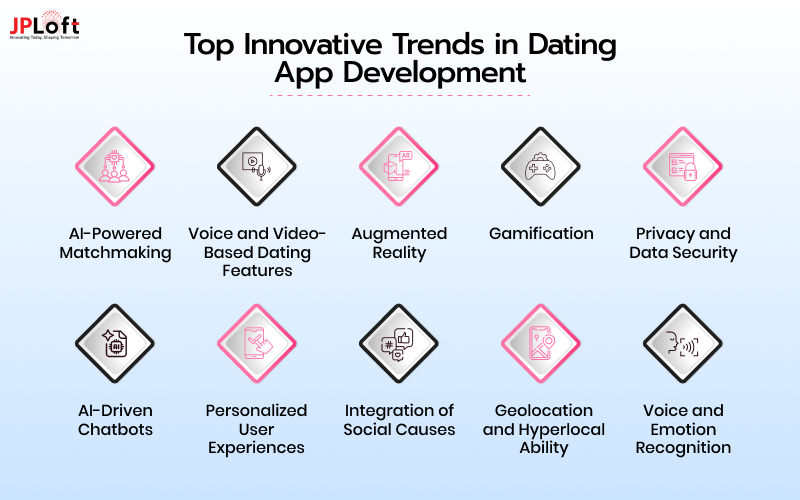
Here are some of the latest dating app development trends that are reshaping the definition of online time.
1] AI-Powered Matchmaking
With users seeking increasingly personalized experiences, AI-Driven Matchmaking has emerged as an essential feature in the best dating apps for personalized matching. Utilizing AI in dating apps, developers have the ability to design algorithms that assess user preferences, behaviors, and personality characteristics to suggest extremely compatible matches.
This advanced application of AI may even include emotion recognition in dating and analyzing user interactions to enhance comprehension of compatibility and forecast relationship success. Using AI-generated suggestions, users enjoy a more personalized and significant matchmaking experience.
2] Voice and Video-Based Dating Features
Voice and video have become essential Voice and Video Dating Features for those who want a safer and more authentic way to connect before meeting in person. Through these dating app features, users can experience a more genuine interaction, allowing them to gauge personality and comfort levels in real time.
These trends in dating app development reduce the reliance on text alone and help users feel more connected. As a result, dating apps with strong video and voice functionalities are shaping the future of dating apps by giving users more control and confidence in their interactions.
3] Augmented Reality (AR) Experiences
AR and VR in Dating Apps are taking virtual dating to a new level by offering immersive and interactive date options. Through Augmented Reality (AR) Experiences, trends in dating apps are creating virtual environments for shared experiences, such as virtual coffee dates or fun mini-games.
These AR-driven features are excellent icebreakers, helping users to bond in creative ways. By enabling users to participate in virtual activities, AR allows for a unique twist on traditional dating, especially for those who may be hesitant about in-person meetings initially.
4] Gamification and Interactive Features
Gamification introduces a fun aspect that maintains user involvement and promotes interaction, essential in today’s competitive dating scene. Gamification in dating apps includes quizzes, challenges, and events that users can participate in together, helping to break the ice and foster connections.
These interactive features are designed to enhance the user experience and promote bonding through shared activities. By blending fun elements with traditional dating app features, gamification creates a vibrant atmosphere that differentiates the best apps from the rest.
5] Enhanced Privacy and Data Security
User privacy and safety have become very necessary because safe and secure dating app features are at the forefront with improved safety protocols. Advanced identity verification methods, anti-fraud algorithms, and secure in-app protocols are a few of the ways applications ensure user safety.
For users who prioritize a reliable atmosphere, improved privacy and security measures enable them to concentrate on significant connections without concerns about privacy violations or deceptive interactions. As dating apps develop further, strong security protocols are essential for fostering user trust and providing a favorable experience.
6] AI-Driven Chatbots and Icebreakers
Initiating chats on dating apps can often be uncomfortable, prompting AI-powered chatbots and Icebreakers to transform the experience. By utilizing AI, these chatbots provide tailored conversation initiators and prompts, assisting users in maintaining a smooth dialogue.
By proposing engaging icebreakers or sending soft nudges for chats that haven’t received responses, these AI functionalities simplify the process for users to engage and sustain dialogues, enhancing the interactive charm of dating applications.
7] Personalized User Experiences with Machine Learning
Today’s users expect customized experiences, and Machine Learning for Dating Apps makes this possible by tailoring recommendations to each user’s preferences and evolving habits. Apps are now able to analyze individual behaviors and update match suggestions based on users’ interactions and feedback.
This ability to personalize the experience helps users feel more engaged and satisfied, as they’re shown content and matches that truly align with their preferences, creating a unique and adaptive user experience.
8] Integration of Social Causes or Value-Based Matching
As people seek more meaningful connections, value-based dating apps are catering to those who prioritize shared values and causes. These apps help users find like-minded individuals by matching them based on social causes, such as environmental activism, charity involvement, or community support.
This value-based approach makes it easier for users to connect with those who share their passions and ideals, ultimately fostering deeper, more genuine relationships.
9] Geolocation and Hyperlocal Ability
Geolocation and hyperlocal features have redefined how quickly users can meet potential matches nearby. By allowing users to find connections in their immediate vicinity or at specific events, these make it easier to transition from digital interactions to real-life meetings.
Whether users are looking for someone at a festival or a local café, hyperlocal tools facilitate fast in-person connections, offering a blend of convenience and immediacy that appeals to modern daters.
10] Voice and Emotion Recognition for Better Matching
With the addition of Voice and Emotion Recognition, dating apps are enhancing compatibility significantly. This technology examines users' voices and emotional signals, aiding in the improvement of match recommendations based on personality characteristics and mood.
Emotion recognition can interpret how a user expresses themselves, offering insights into compatibility that go beyond traditional text and profile information. However, adding advanced technologies can be one of the most difficult dating app development challenges. This makes matches feel more authentic and attuned to individual personalities, enhancing the overall dating experience.
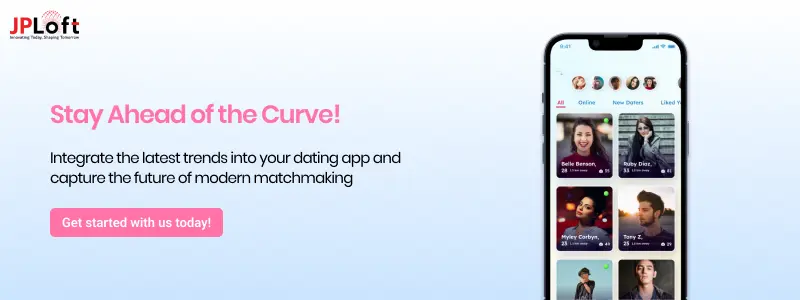
Best Use Cases Of Innovative Trends
Here’s a list of the Top 8 Use Cases showcasing how leading dating apps are using these trends to enhance user experience. Including examples from popular apps helps illustrate how these trends are implemented in real-world scenarios.
1. AI-Powered Matchmaking - Tinder’s Smart Photo Selection
Tinder has integrated AI-powered features to improve match recommendations, with AI-Powered Matchmaking taking center stage.
One example is their Smart Photo feature, which uses machine learning to reorder photos in a way that maximizes match potential based on user interaction data.
This can be an inspiration for anyone looking to create a dating app like Tinder.
This AI-driven approach helps users showcase their best images first, increasing compatibility. Such AI solutions highlight Tinder's investment in creating a more intuitive user experience, setting an example as iOS app development services that wish to integrate personalized, data-driven features.
2. Voice and Video-Based Dating Features - Bumble’s Video Chat
Bumble introduced voice and video calling to allow users to connect in a more personal way before meeting in person. These Voice and Video Dating Features provide a safer alternative for users who may be hesitant about immediate in-person meetings.
By integrating video, Bumble allows users to get a better sense of who they’re connecting with, building trust and confidence. These functionalities increase the Bumble-like app development cost. Still, it also makes them stand out and value user safety and engagement, making voice and video essential tools for deeper connections.
3. AR and VR Dating Experiences - Flirtual’s Virtual Reality Dates
Flirtual, a dating app designed for VR enthusiasts, offers AR and VR in Dating Apps by letting users participate in virtual reality dates. Through immersive environments, users can “meet” and engage with others in various virtual spaces, which adds a fun, futuristic twist to online dating.
As an increasing number of users adopt AR and VR technology, this trend highlights how immersive experiences are turning into an essential differentiator.
4. Enhanced Privacy and Security Features - Hinge’s Video Verification
Hinge takes user safety seriously by offering a video verification feature to confirm user identity, a prime example of Enhanced Privacy and Security Features in dating apps. This feature requires users to submit a short video, which is then matched against their profile photos to ensure authenticity.
By reducing the risk of catfishing, Hinge builds a more secure environment that resonates with today’s users. Such privacy enhancements are becoming essential for developing a mobile app, resulting in high Hinge-like app development cost.
5. Gamification In Dating Apps - OkCupid’s Interactive Questions
OkCupid employs gamification via an engaging question-and-answer platform that assists users in discovering matches aligned with common values and interests. This aspect of gamification in dating apps not only facilitates initial interactions but also boosts user involvement by making the experience of seeking a match more entertaining.
By allowing users to answer questions and compare answers with potential matches, OkCupid creates a more meaningful, customized experience. Such gamified features serve as excellent examples of advanced dating app features, offering engaging, interactive elements into their apps.
6. Personalized User Experiences with Machine Learning - eHarmony’s Compatibility Matching System
eHarmony has been a pioneer in personalized matchmaking through its Compatibility Matching System, which uses Machine Learning for Dating Apps to tailor matches to individual preferences, habits, and personalities. By analyzing user data and interactions over time, eHarmony provides evolving match suggestions that feel increasingly accurate.
This machine learning approach has made eHarmony one of the best dating apps for personalized matching, demonstrating how intelligent recommendations can make the dating experience more fulfilling and customized.
7. Geolocation and Hyperlocal Features - Happn’s Real-Time Location Matching
Happn leverages geolocation and hyperlocal features by connecting users who cross paths in real life, showing potential matches based on proximity and real-time location data. This hyperlocal approach fosters immediate connections, giving users a chance to meet those nearby without needing to plan extensively.
Happn’s real-time location matching provides a unique blend of convenience and immediacy, a valuable tool for those looking for spontaneous connections. This feature also highlights the role of geolocation in enhancing user engagement, offering a useful direction, hire iOS app developers who want to prioritize location-based features.
How These Trends Are Shaping the Future of Dating Apps
The swift embrace of emerging technologies is changing dating apps into far more than simple match-making tools—they are increasingly evolving into environments for secure, captivating, and highly tailored interactions. 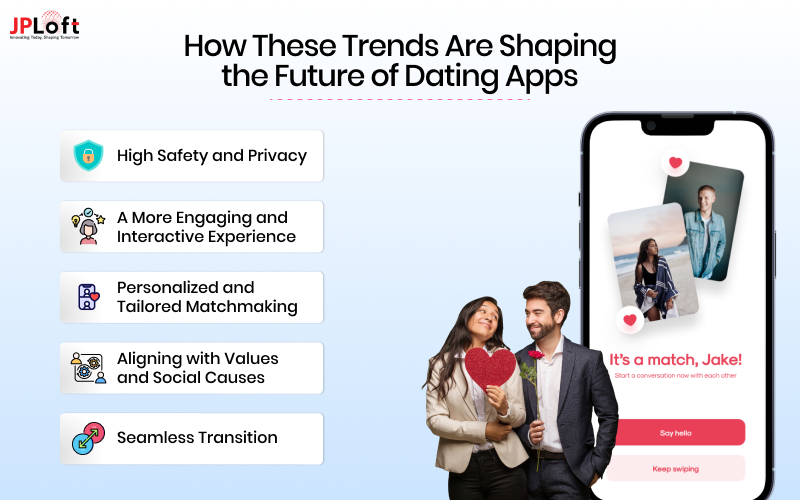
Here’s how these leading trends are influencing the Future of Dating Apps:
► High Safety and Privacy
Dating apps are emphasizing user safety by implementing advanced privacy and security features such as video verification and real-time monitoring to foster a dependable atmosphere. Elements like identity confirmation and anti-scam algorithms assist in filtering suspicious profiles, ensuring users feel assured they are engaging with genuine individuals.
This commitment to safety is essential in the current digital era, aiding dating apps in establishing trust and keeping users who might otherwise be reluctant to interact online. Though privacy and security features are necessary elements, it increases the cost to develop a dating app.
► A More Engaging and Interactive Experience
Trends such as gamification in dating apps, Augmented Reality (AR) Features, and Voice and Video Dating Options enhance dating apps significantly by introducing interactive components that surpass basic messaging. Gamified elements like quizzes and ice-breakers facilitate users in starting conversations, while AR and VR functionalities enable them to interact in creative and engaging manners.
By incorporating these fun, interactive options, dating apps create a richer user experience that increases engagement and helps users form connections in creative, enjoyable ways.
► Personalized and Tailored Matchmaking
The emergence of AI-Enhanced Matchmaking and Machine Learning for Dating Applications enables dating platforms to provide tailored suggestions. Through the examination of user data, preferences, and emotional signals, these smart algorithms recommend matches that are likely to better fit a user’s personality and values.
This degree of personalization allows users to discover more suitable matches while also enhancing their dating satisfaction, as they receive match recommendations that align with their true selves.
► Aligning with Values and Social Causes
For modern daters, shared values play a big role in compatibility. With value-based dating apps that align with social causes, users can now connect with others who share similar beliefs, passions, or life goals.
By matching users based on common values, dating apps are helping people build more meaningful relationships rooted in shared beliefs, making the dating experience feel less random and more purposeful.
► Seamless Transition from Digital to Real-World Interactions
Features like geolocation and hyperlocal matching bridge the gap between digital and real-life interactions, helping users connect with others nearby or at specific events. This ability to meet people in real-time creates a seamless transition from virtual introductions to in-person connections, enhancing user satisfaction and adding an exciting immediacy to dating app interactions.
JPLoft: Leveraging Emerging Technologies to Develop Innovative Dating Applications
At JPLoft, we take pride in leading the way as the best dating app development company. Our group of skilled developers, QA experts, designers, and project managers has significant practical experience in creating strong, feature-packed dating platforms that incorporate the latest technologies.
Whether it’s AI-Enhanced Matchmaking, Voice and Video Dating Functionality, or AR and VR in Dating Applications, we make certain that each project is developed with a sharp focus on market trends and user requirements.
JPLoft creates dating apps that emphasize safety, customization, and interaction. We aim to create a dating app that provides safe, smooth experiences, featuring improved privacy measures and user-friendly interfaces that keep individuals connected and involved.
From conception to launch, our team employs a strategic method, working together closely to guarantee that every app reflects the most recent advancements in dating app technology and design. Through the use of cutting-edge technologies, JPLoft creates dating platforms that not only adhere to existing industry standards but also establish new criteria for user experience, safety, and innovation.
Conclusion
Dating apps have come a long way from simple swiping interfaces to becoming the matchmaking platform. Paired with convincing examples like specialized pairing or event-driven communication, dating apps are now more personalized, secure, and interactive than ever.
But user expectations have shifted. It is no longer just about finding a match, it’s about feeling safe, valued, and understood. That’s where today’s most exciting dating app development trends come in.
From AI-driven matchmaking that tailors suggestions to individual preferences, to advanced privacy features ensuring a secure experience, these innovations are changing the way people date online. As the digital dating world continues to evolve, these trends are reshaping the future of connection.
FAQs
The top dating app development trends for 2025 include AI-Powered Matchmaking, Voice and Video-Based Dating Features, Augmented Reality (AR) Experiences, Gamification and Interactive Features, Enhanced Privacy and Security Features, and Value-Based Matching. These trends are focused on creating more personalized, secure, and engaging user experiences.
AI enhances dating apps by analyzing user data to make intelligent match recommendations based on preferences, interests, and behavior. It can also suggest conversation starters and monitor user activity to improve safety, resulting in a more personalized and enjoyable experience for users.
Privacy and security features are crucial in dating apps to protect users from scams, fake profiles, and data breaches. Features like identity verification, anti-scam algorithms, and in-app security protocols provide a safer environment, helping users feel confident and secure while using the app.
JPLoft uses emerging technologies like AI, AR, and machine learning to create cutting-edge dating apps that meet industry standards and exceed user expectations. Our team of developers, designers, and QA specialists works collaboratively to integrate these technologies and build apps that are robust, secure, and user-friendly.
Absolutely! JPLoft offers comprehensive iOS app development services for dating apps. Our expertise extends across platforms, including both iOS and Android, ensuring a high-quality user experience tailored to each platform.
AR and VR are used in dating apps to create immersive virtual dating experiences, such as virtual coffee dates, games, or interactive spaces where users can meet and interact. These technologies allow users to connect in new, engaging ways, making online dating feel more authentic and exciting.
The future of dating apps lies in creating highly personalized, secure, and interactive experiences. As trends like AI-driven personalization, AR/VR, and value-based matching continue to grow, dating apps are becoming platforms where users can form genuine, meaningful connections that go beyond traditional swiping.





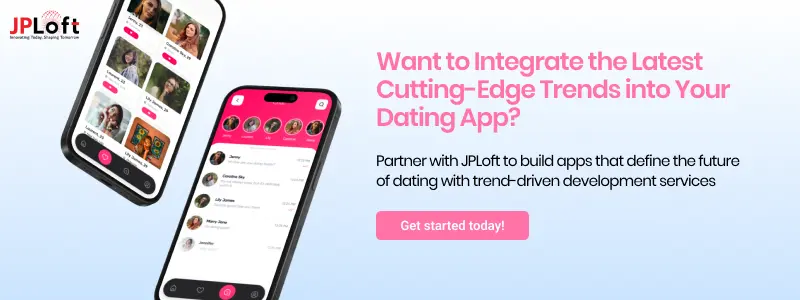

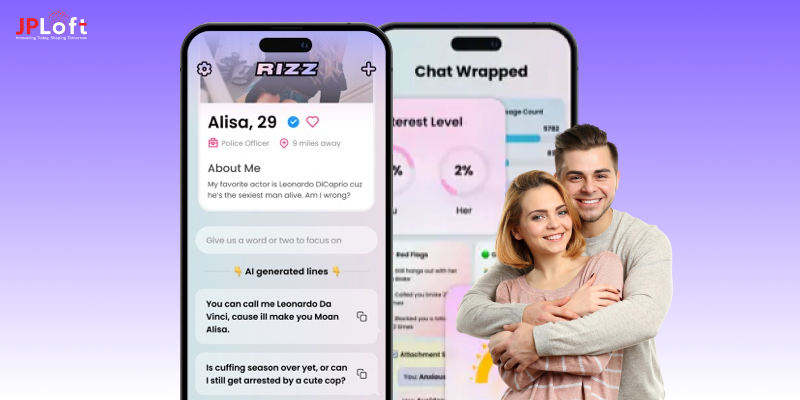
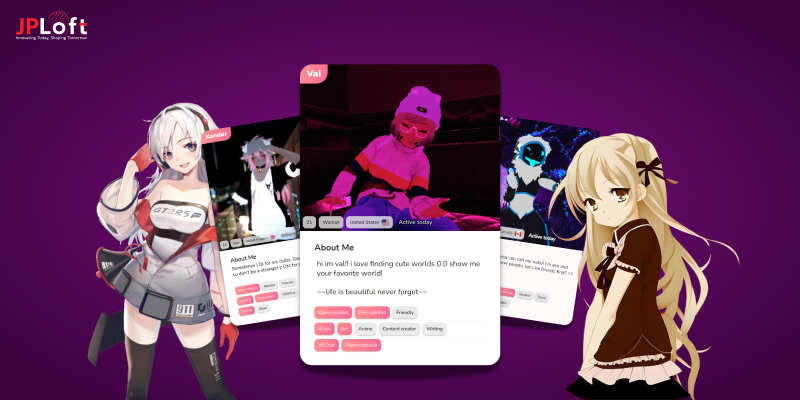
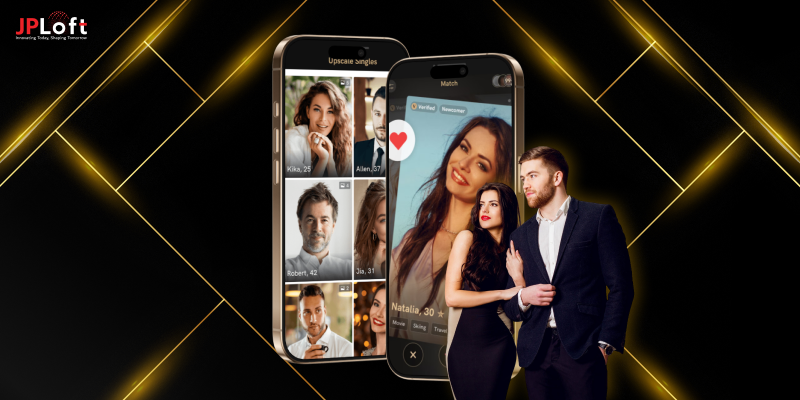



Share this blog